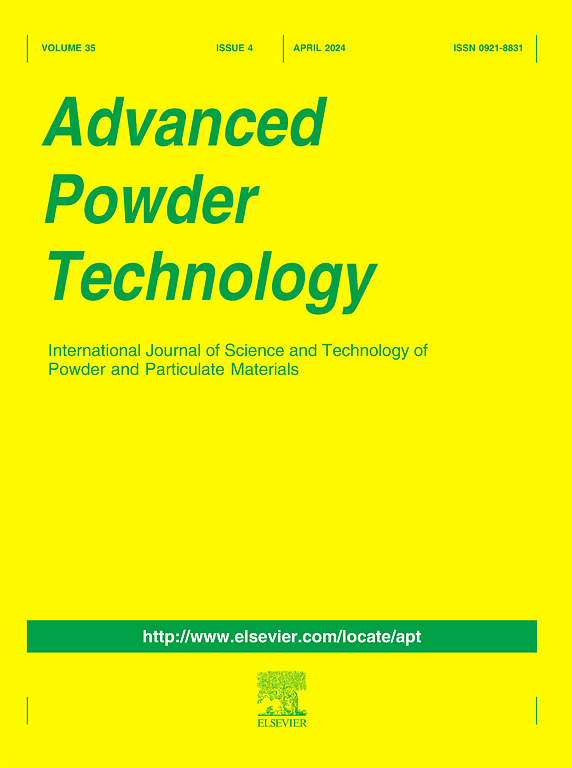用于方解石和菱镁矿浮选分离的无毒可生物降解抑制剂阿拉伯胶:实验和MD模拟
IF 4.2
2区 工程技术
Q2 ENGINEERING, CHEMICAL
引用次数: 0
摘要
本研究以绿色环保、可生物降解的有机大分子试剂阿拉伯胶(GA)作为一种新型抑制剂,用于菱镁矿和方解石的反浮选分离。微浮选试验表明,GA对菱镁矿具有选择性抑制作用。在人工混合矿物中,添加70 mg/L GA可获得MgO品位为31.39%、MgO回收率为80.31%的精矿。机理研究表明,GA在菱镁矿表面的吸附主要是通过菱镁矿表面的Mg位点与GA表面的羟基和羧基的化学螯合作用,而在方解石表面的吸附主要是通过氢键作用。加入NaOL后,它可以进一步吸附在方解石表面,而在菱镁矿上的吸附则比较困难。此外,水分子的空间分布和径向分布函数(RDF)提供了微观证据,证明GA可以扩大菱镁矿和方解石表面的疏水性差异。最终,两种矿物的可浮性差异显著增大。因此,GA可作为菱镁矿反浮选分离的新型高选择性抑制剂。本文章由计算机程序翻译,如有差异,请以英文原文为准。

Non-toxic and biodegradable depressant Gum Arabic for flotation separation of calcite and magnesite: Experiments and MD simulations
In this study, Gum arabic (GA), a green, environmentally friendly, and biodegradable organic macromolecule reagent, is employed as a novel depressant for the reverse flotation separation of magnesite and calcite. The micro-flotation tests demonstrate that GA exhibits a selective depression impact on magnesite. From artificial mixed minerals, a concentrate with a MgO grade of 31.39 % and a MgO recovery of 80.31 % can be obtained using 70 mg/L of GA. The mechanism studies reveal that GA adsorbs on the magnesite surface mainly via chemical chelation between Mg sites on the magnesite surface and hydroxyl and carboxyl groups on GA, while it mainly adsorbs through hydrogen bonding on the calcite surface. After adding NaOL, it can further adsorb on the calcite surface, while its adsorption on magnesite is more difficult. Moreover, the spatial distribution of water molecules and the radial distribution function (RDF) provides microscopic proof that GA can expand the differences in hydrophobicity between magnesite and calcite surfaces. Eventually, the difference in the floatability of the two minerals increases significantly. Therefore, GA can be adopted as a novel and highly selective depressant for the reverse flotation separation of magnesite.
求助全文
通过发布文献求助,成功后即可免费获取论文全文。
去求助
来源期刊

Advanced Powder Technology
工程技术-工程:化工
CiteScore
9.50
自引率
7.70%
发文量
424
审稿时长
55 days
期刊介绍:
The aim of Advanced Powder Technology is to meet the demand for an international journal that integrates all aspects of science and technology research on powder and particulate materials. The journal fulfills this purpose by publishing original research papers, rapid communications, reviews, and translated articles by prominent researchers worldwide.
The editorial work of Advanced Powder Technology, which was founded as the International Journal of the Society of Powder Technology, Japan, is now shared by distinguished board members, who operate in a unique framework designed to respond to the increasing global demand for articles on not only powder and particles, but also on various materials produced from them.
Advanced Powder Technology covers various areas, but a discussion of powder and particles is required in articles. Topics include: Production of powder and particulate materials in gases and liquids(nanoparticles, fine ceramics, pharmaceuticals, novel functional materials, etc.); Aerosol and colloidal processing; Powder and particle characterization; Dynamics and phenomena; Calculation and simulation (CFD, DEM, Monte Carlo method, population balance, etc.); Measurement and control of powder processes; Particle modification; Comminution; Powder handling and operations (storage, transport, granulation, separation, fluidization, etc.)
 求助内容:
求助内容: 应助结果提醒方式:
应助结果提醒方式:


